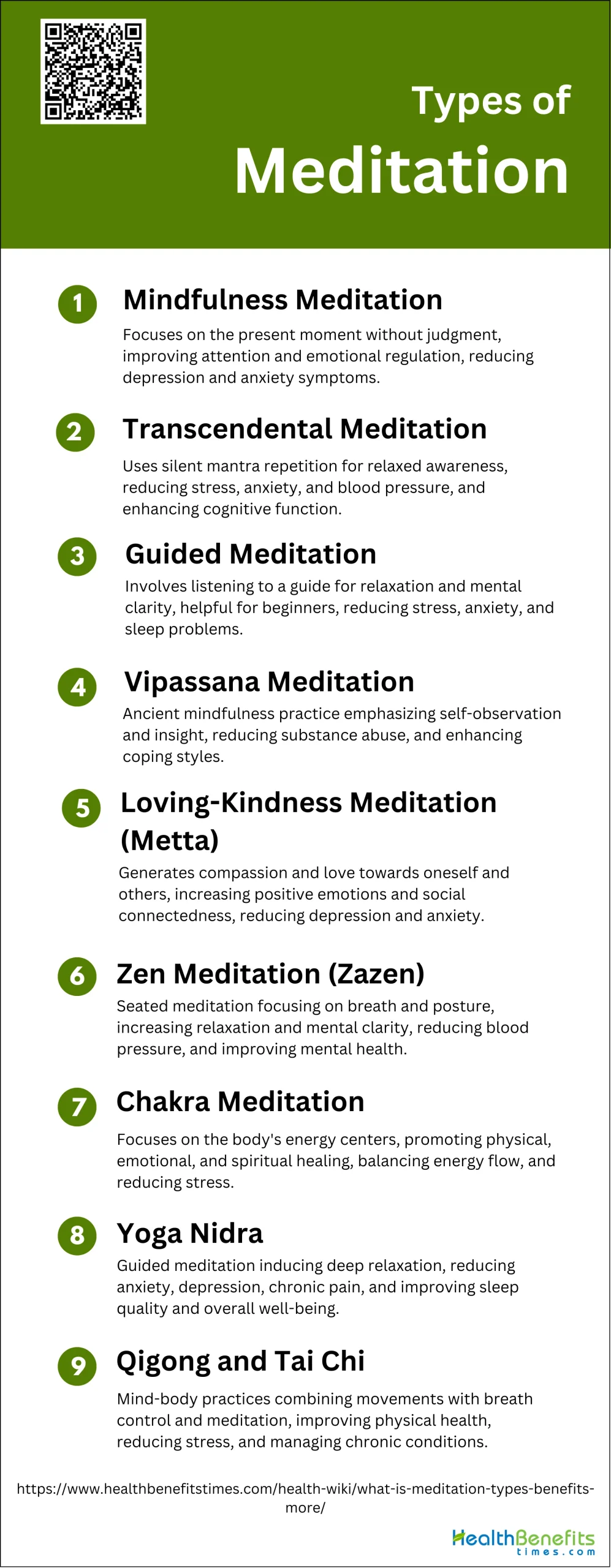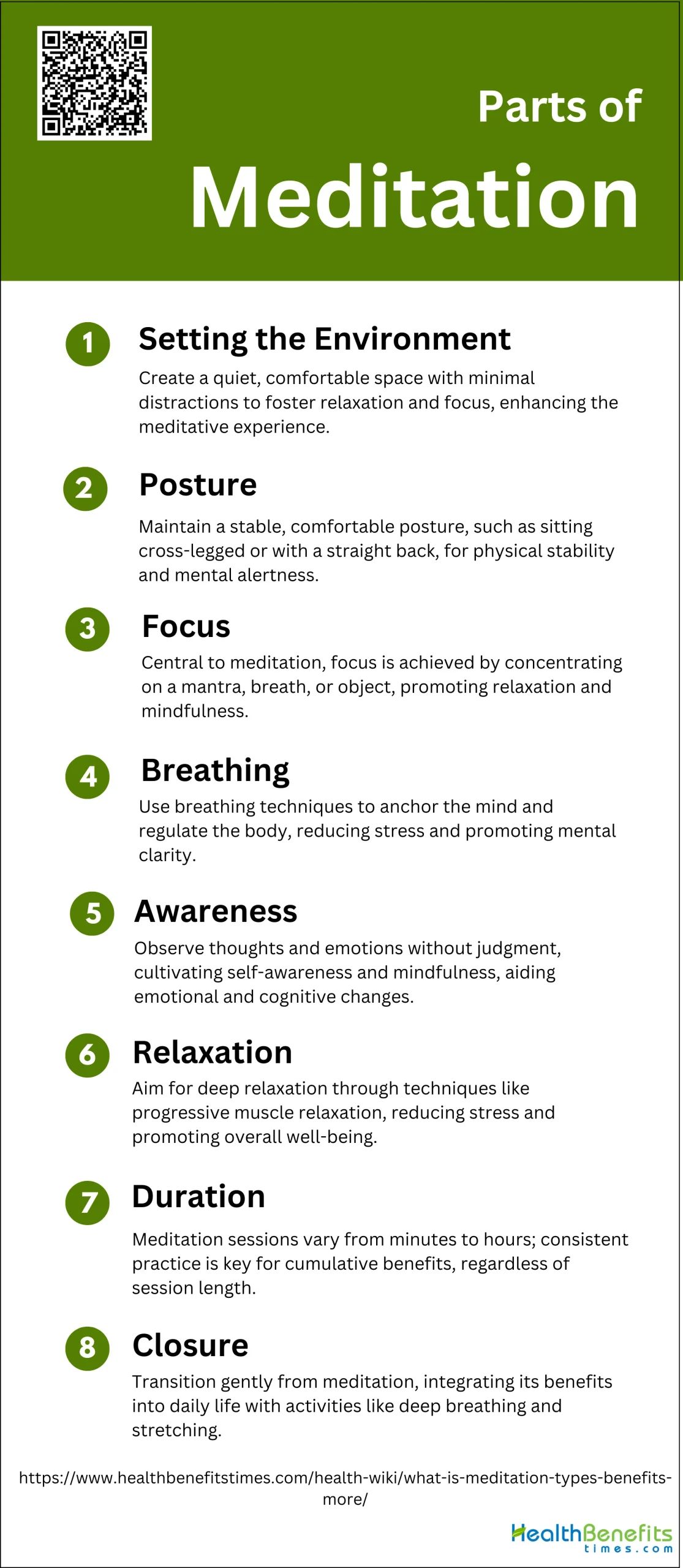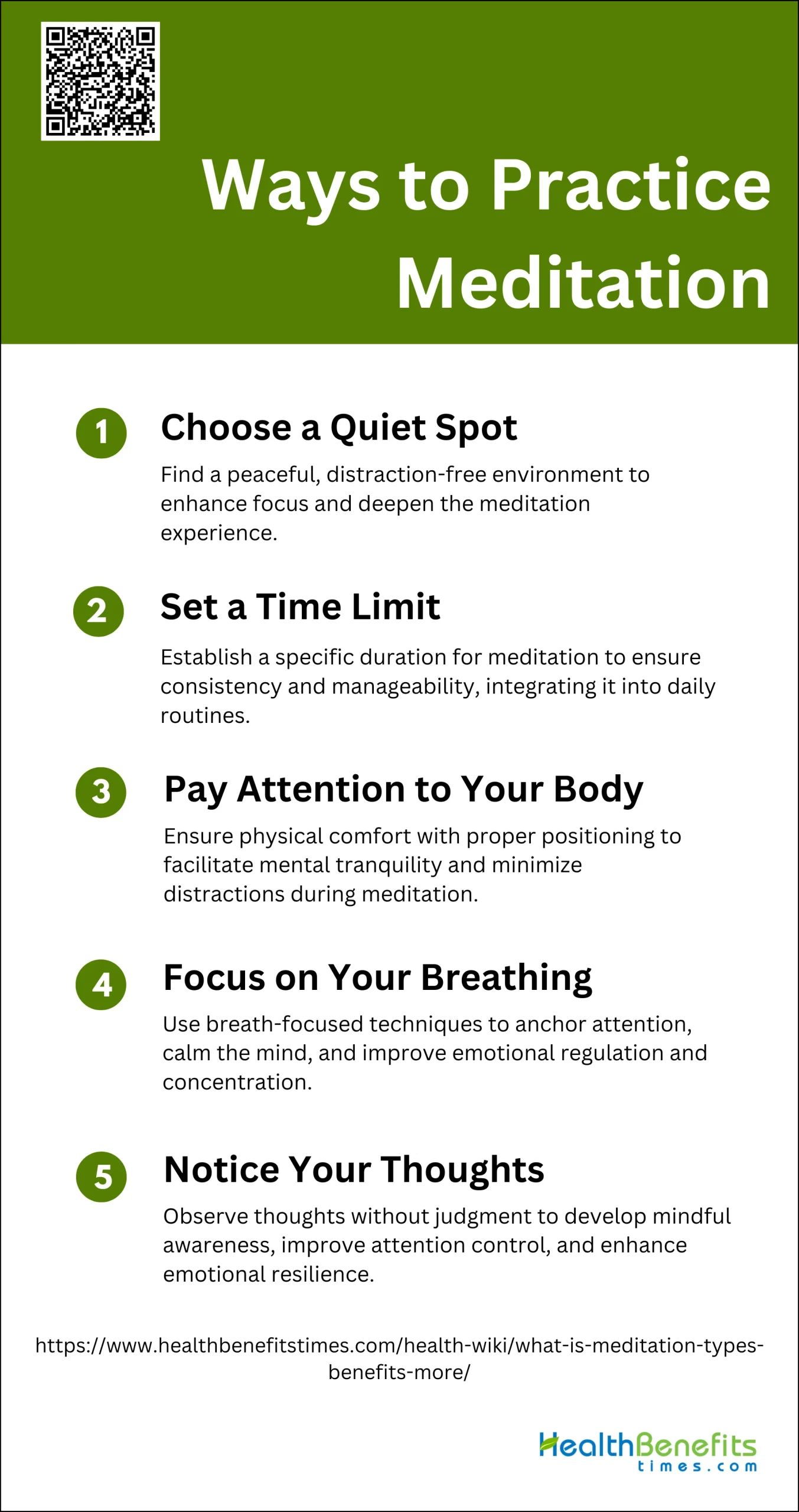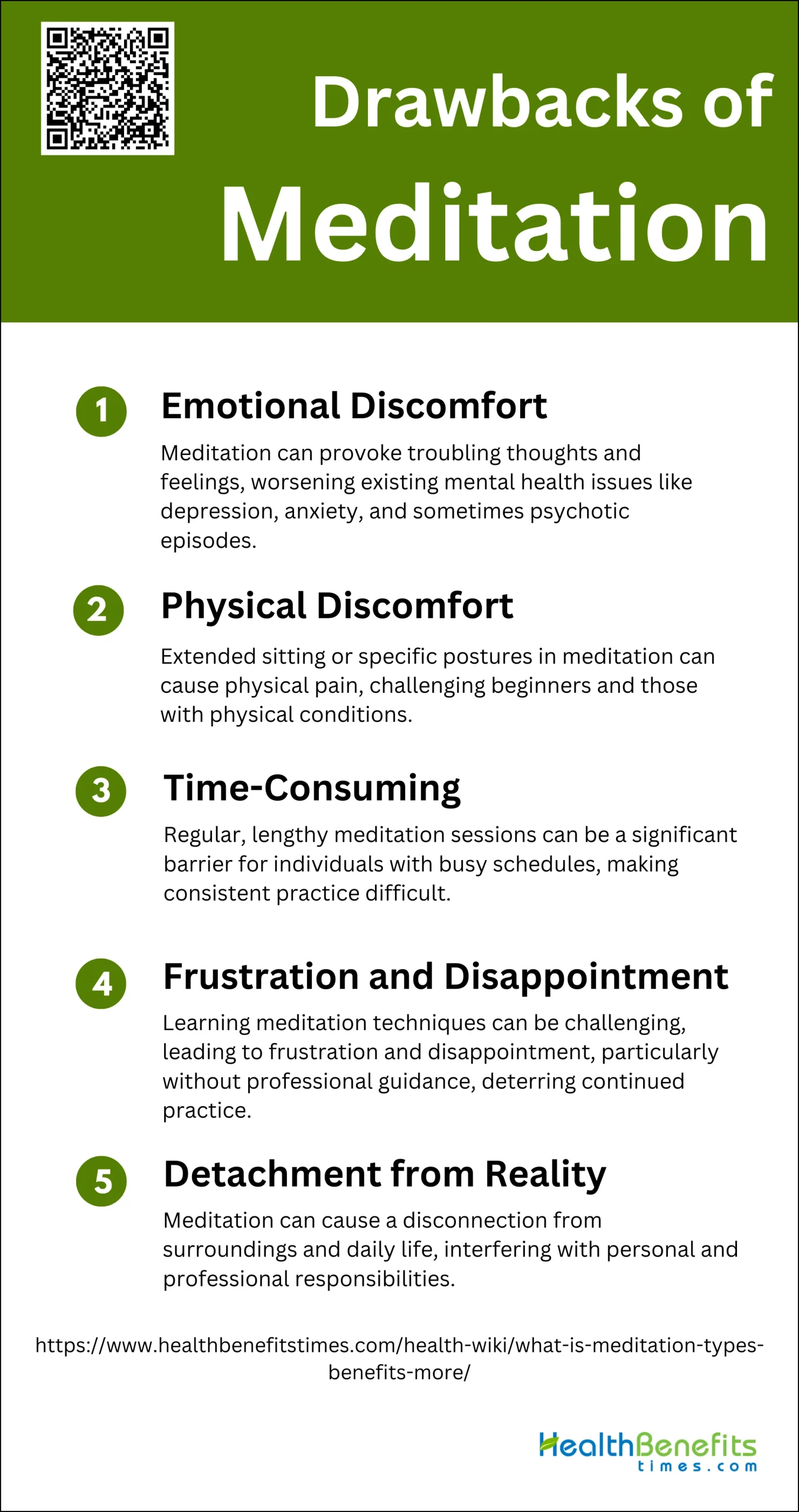 Meditation is a multifaceted practice that encompasses a wide range of techniques aimed at achieving a state of heightened conscious awareness and inner stillness. It is often described as a state of single-minded concentration or “restful alertness,” where the mind is focused yet relaxed. Unlike mere physical relaxation, meditation engages both the mind and body, fostering a sense of inner peace, stillness, and detachment from the continuous stream of mental activity. Techniques vary widely, from mindful observation and body-centered practices to visual concentration and mantra meditation, each offering unique benefits and experiences. The essence of meditation lies in transcending the habitual “doing” of the waking state to simply “being,” thereby enhancing autonomy, self-control, and effective action.
Meditation is a multifaceted practice that encompasses a wide range of techniques aimed at achieving a state of heightened conscious awareness and inner stillness. It is often described as a state of single-minded concentration or “restful alertness,” where the mind is focused yet relaxed. Unlike mere physical relaxation, meditation engages both the mind and body, fostering a sense of inner peace, stillness, and detachment from the continuous stream of mental activity. Techniques vary widely, from mindful observation and body-centered practices to visual concentration and mantra meditation, each offering unique benefits and experiences. The essence of meditation lies in transcending the habitual “doing” of the waking state to simply “being,” thereby enhancing autonomy, self-control, and effective action.
History of meditation practices
The history of meditation practices is rich and varied, spanning multiple cultures and centuries. In early Buddhist discourse, mindfulness-related meditations were central, not only for monastics but also for lay practitioners, indicating a broad doctrinal and cosmological significance. In Siam and Laos, traditional meditation practices, known as boran kammatthan, were prevalent from the sixteenth century until they were overshadowed by Burmese Vipassana and Thai Forest tradition techniques in the twentieth century. Hinduism’s meditation practices, particularly yoga, have been integral since India’s axial age, focusing on achieving non-cognitive samādhi through techniques like breath control and sensory withdrawal, as systematized by Patañjali in the fourth century CE. Zen Buddhism, especially through the teachings of the thirteenth-century Japanese master Dogen, emphasizes “just sitting” or zazen, a practice aimed at achieving a state of “nonthinking” to align with the higher consciousness of the “Buddha mind”. Additionally, Buddhist meditation has evolved to include both mindfulness and visualization techniques, with early practices focusing on mindful breathing and corpse decomposition, and later developments incorporating Buddha visualization, which remains a significant practice in Esoteric Buddhism today.
Types of Meditation
There are several types of meditation, each with its unique approach and benefits. Here are some common types:
1. Mindfulness Meditation
Mindfulness meditation (MM) involves focusing on the present moment and accepting it without judgment. Neuroimaging studies have shown that MM activates the prefrontal cortex and anterior cingulate cortex, enhancing areas related to attention and emotional regulation. Clinically, MM has been effective in reducing symptoms of various psychiatric disorders, including depression and anxiety, and improving overall well-being in healthy individuals. Mindfulness-Based Stress Reduction (MBSR) and Mindfulness-Based Cognitive Therapy (MBCT) are popular programs that utilize MM techniques to manage stress and prevent depression relapse.
2. Transcendental Meditation
Transcendental Meditation (TM) is a form of silent mantra meditation where practitioners repeat a specific mantra to achieve a state of relaxed awareness. TM has been shown to reduce stress and anxiety, improve cardiovascular health, and enhance cognitive function. Unlike other forms of meditation, TM does not require concentration or contemplation, making it accessible to a wide range of individuals. Studies have indicated that TM can lead to significant reductions in blood pressure and improvements in overall mental health, although more high-quality research is needed to confirm these findings.
3. Guided Meditation
Guided meditation involves listening to a guide who leads the practitioner through a series of visualizations or instructions to achieve relaxation and mental clarity. This form of meditation is particularly useful for beginners as it provides structure and direction. Guided meditation can be used to address specific issues such as stress, anxiety, and sleep problems. Research has shown that guided meditation can effectively reduce symptoms of depression and anxiety, improve sleep quality, and enhance overall well-being.
4. Vipassana Meditation
Vipassana meditation (VM) is an ancient mindfulness practice that focuses on self-observation and insight. Neuroimaging studies suggest that VM activates the prefrontal and anterior cingulate cortex, and increases cortical thickness in areas related to attention. Clinically, VM has shown promise in reducing alcohol and substance abuse among incarcerated individuals, although its effects on post-traumatic stress disorder are less clear. VM also appears to enhance mature defense mechanisms and coping styles in healthy individuals.
5. Loving-Kindness Meditation (Metta)
Loving-Kindness Meditation (Metta) involves generating feelings of compassion and love towards oneself and others. This practice has been shown to increase positive emotions, reduce negative emotions, and improve overall psychological well-being. Neuroimaging studies indicate that Metta meditation activates brain areas associated with emotional regulation and empathy. Clinically, it has been effective in reducing symptoms of depression, anxiety, and post-traumatic stress disorder, and in enhancing social connectedness and emotional resilience.
6. Zen Meditation (Zazen)
Zen meditation (Zazen) is a form of seated meditation that emphasizes mindfulness and concentration. Practitioners focus on their breath and maintain a specific posture to achieve mental clarity and emotional calm. EEG studies have shown that Zazen increases alpha and theta brain wave activity, which are associated with relaxation and focused attention. Clinically, Zazen has been found to reduce blood pressure and improve mental health outcomes, although more research is needed to fully understand its benefits.
7. Chakra Meditation
Chakra meditation involves focusing on the body’s energy centers, or chakras, to promote physical, emotional, and spiritual healing. Practitioners visualize each chakra and use specific mantras or breathing techniques to balance and align their energy. This form of meditation is believed to enhance overall well-being by improving the flow of energy throughout the body. While scientific research on chakra meditation is limited, anecdotal evidence suggests it can reduce stress, improve emotional health, and increase spiritual awareness.
8. Yoga Nidra
Yoga Nidra, or yogic sleep, is a guided meditation practice that induces deep relaxation and a state of conscious awareness between waking and sleeping. It involves a series of body scans, breath awareness, and visualizations to achieve a state of profound rest. Research has shown that Yoga Nidra can reduce symptoms of anxiety, depression, and chronic pain, and improve sleep quality and overall well-being. It is particularly effective for individuals with stress-related disorders and those seeking deep relaxation.
9. Qigong and Tai Chi
Qigong and Tai Chi are mind-body practices that combine slow, deliberate movements with breath control and meditation. These practices are designed to cultivate and balance the body’s vital energy, or Qi. Research has shown that Qigong and Tai Chi can improve physical health, reduce stress, and enhance mental well-being. They have been found to be effective in managing chronic conditions such as arthritis, hypertension, and anxiety, and in improving overall quality of life.
Parts of meditation
Meditation typically involves several key components that help guide the practice and enhance its benefits. Here are the main parts of meditation:
1. Setting the Environment
Creating an optimal environment is crucial for effective meditation. A quiet, comfortable space free from distractions helps in achieving a state of relaxation and focus. The environment should be conducive to mental focusing, which is essential for eliciting the relaxation response. This can include dim lighting, comfortable seating, and perhaps some calming background music or nature sounds. The goal is to create a space where one can easily detach from external stimuli and turn inward, facilitating a state of tranquility and heightened awareness.
2. Posture
Maintaining a proper posture is fundamental in meditation practices. A stable and comfortable posture helps in sustaining longer periods of meditation without physical discomfort. Traditional postures such as sitting cross-legged or in a chair with a straight back are commonly recommended. Proper posture not only aids in physical stability but also supports mental alertness and focus, which are critical for achieving the desired meditative state. The alignment of the spine is particularly important as it allows for better breathing and energy flow throughout the body.
3. Focus
Focus is a central element of meditation, often achieved through techniques such as concentrating on a mantra, breath, or a specific object. This mental focusing is essential for eliciting the relaxation response and achieving a state of deep relaxation and internalized attention. By consistently returning the mind to the chosen point of focus whenever it wanders, practitioners can cultivate a heightened state of awareness and mindfulness, which are key components of many meditation practices.
4. Breathing
Breathing techniques play a significant role in meditation, often used to anchor the mind and regulate the body’s physiological state. Practices such as yoga breathing (pranayama) can rapidly bring the mind to the present moment and reduce stress. Different meditation techniques may involve various breathing patterns, each affecting heart rate and respiratory dynamics differently. Controlled breathing helps in reducing sympathetic arousal, thereby promoting a state of relaxation and mental clarity.
5. Awareness
Awareness in meditation involves observing thoughts, emotions, and bodily sensations without judgment. This heightened state of self-awareness is a key aspect of mindfulness meditation, which can lead to significant emotional and cognitive changes. By cultivating awareness, practitioners can better understand their mental and emotional patterns, which can be therapeutic and aid in behavior modification goals. Awareness practices help in developing a deeper connection with oneself and the present moment.
6. Relaxation
Relaxation is both a goal and a byproduct of meditation. Techniques such as progressive muscle relaxation, autogenic training, and repetitive prayer can elicit the relaxation response, characterized by reduced heart rate, breathing rate, and oxygen consumption. While some forms of meditation may involve mental effort and physiological arousal, the overall aim is to achieve a state of deep relaxation and tranquility. This relaxed state is beneficial for both mental and physical health, aiding in stress reduction and overall well-being.
7. Duration
The duration of meditation sessions can vary widely, from a few minutes to several hours, depending on the practice and the individual’s experience level. Shorter sessions may be more accessible for beginners, while longer durations can deepen the meditative experience and its benefits. Consistent practice over time is more important than the length of individual sessions, as regular meditation can lead to cumulative benefits such as improved focus, relaxation, and emotional regulation.
8. Closure
Closure in meditation involves gently transitioning out of the meditative state and integrating the experience into daily life. This can include taking a few deep breaths, stretching, or reflecting on the session’s insights and feelings. Proper closure helps in maintaining the benefits of meditation, such as relaxation and heightened awareness, throughout the day. It also ensures that the practitioner returns to their routine activities with a sense of calm and centeredness.
Ways to practice meditation
Meditation offers a variety of techniques to help you achieve mindfulness, reduce stress, and enhance overall well-being. Whether you’re a beginner or an experienced practitioner, there are numerous methods to explore and incorporate into your daily routine. Here are some effective ways to practice meditation:
1. Choose a quiet spot that is free of distractions
Selecting a quiet and distraction-free environment is crucial for effective meditation. Research indicates that the setting significantly impacts the success of mindfulness training. For instance, a study comparing traditional indoor mindfulness training with a garden-based approach found that participants in the natural setting had lower dropout rates and more consistent practice. This suggests that a serene and undisturbed location can enhance compliance and the overall meditation experience. Therefore, finding a peaceful spot can help create the right atmosphere for focusing the mind and achieving a deeper state of meditation.
2. Set a time limit
Setting a specific time limit for meditation can help in maintaining consistency and making the practice more manageable. Studies have shown that even short-term meditation training can yield significant benefits. For example, a study involving five days of 20-minute meditation sessions demonstrated improvements in attention and stress control among participants. By setting a time limit, individuals can integrate meditation into their daily routines without feeling overwhelmed, ensuring that they can reap the benefits of regular practice without it becoming a burden.
3. Pay attention to your body and get comfortable
Ensuring physical comfort is essential for a successful meditation session. Proper body positioning can facilitate mental and emotional peace. Instructions for Zen meditation, for instance, emphasize the importance of positioning the body correctly, whether sitting on a chair, cross-legged, or kneeling. Maintaining physical stillness is crucial as it serves as a gateway to mental tranquility. By paying attention to the body and finding a comfortable position, one can minimize physical distractions and focus more effectively on the meditation practice.
4. Focus on your breathing
Focusing on the breath is a fundamental aspect of many meditation practices. Techniques such as “counting the breaths” in Zen meditation help in concentrating and calming the mind. This method involves counting each breath up to ten and then starting over, which aids in maintaining focus and reducing mental clutter. Research supports the effectiveness of breath-focused meditation in improving attention and emotional regulation. By concentrating on the breath, individuals can anchor their attention, making it easier to achieve a meditative state and experience the associated cognitive and emotional benefits.
5. Notice your thoughts
Observing thoughts without judgment is a key component of meditation. This practice, known as open monitoring meditation, involves nonreactive monitoring of the content of experience from moment to moment. It helps in cultivating a state of mindful awareness where one can acknowledge thoughts and feelings without getting caught up in them. Studies have shown that this approach can improve attention control and emotional balance. By noticing thoughts and letting them pass without attachment, individuals can develop greater mental clarity and emotional resilience, enhancing the overall effectiveness of their meditation practice.
Benefits of Meditation
Meditation offers a wide range of benefits for both mental and physical health. Here are some key advantages: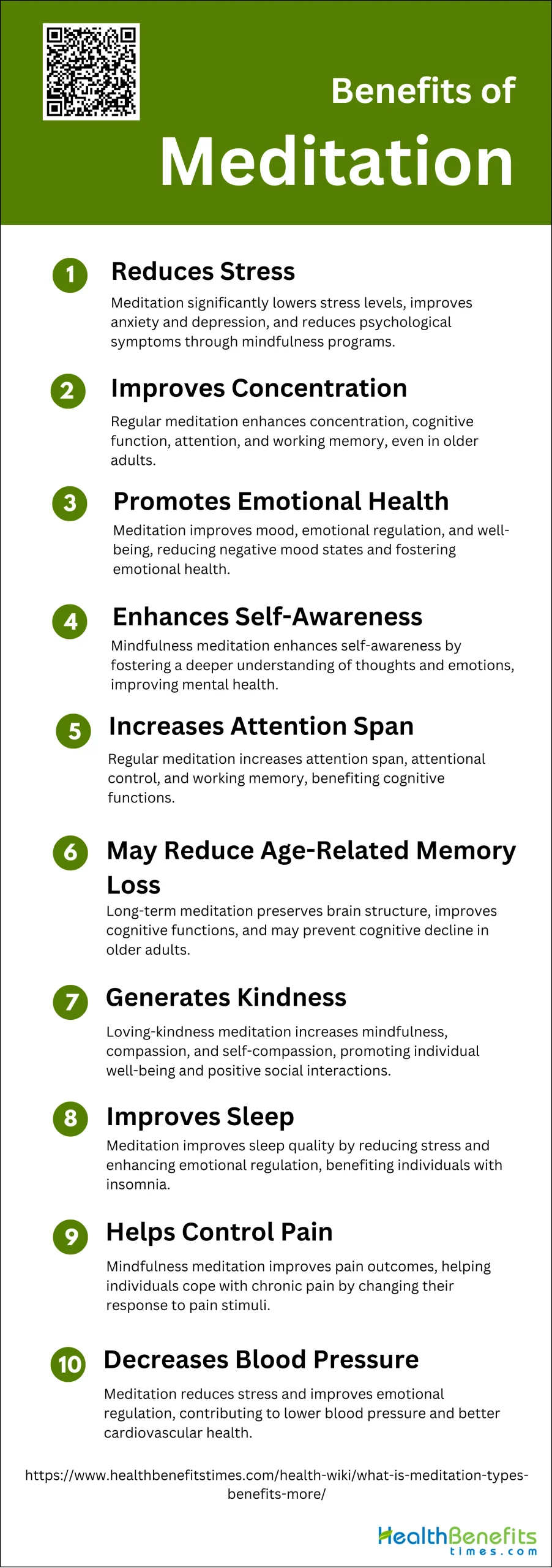
1. Reduces Stress
Meditation has been shown to significantly reduce stress levels. A systematic review and meta-analysis found that mindfulness meditation programs had moderate evidence of improved anxiety and depression, which are key indicators of stress. Additionally, an 8-week mindfulness meditation program demonstrated significant reductions in overall psychological symptomatology and stress-related symptoms. These findings suggest that meditation can be an effective tool for managing stress and improving mental health.
2. Improves Concentration
Meditation practices have been linked to enhanced concentration and cognitive function. A study on non-experienced meditators found that 8 weeks of daily meditation significantly improved attention and working memory. Similarly, research on older adults indicated that mindfulness meditation training improved goal-directed visuospatial attention, which is crucial for maintaining concentration. These improvements in cognitive function highlight the potential of meditation to enhance concentration.
3. Promotes Emotional Health
Meditation has been found to promote emotional health by improving mood and emotional regulation. An 8-week mindfulness meditation program resulted in higher scores on measures of spiritual experiences and emotional well-being. Another study showed that brief daily meditation decreased negative mood states and enhanced emotional regulation. These findings underscore the role of meditation in fostering emotional health and well-being.
4. Enhances Self-Awareness
Meditation practices, particularly mindfulness meditation, emphasize developing a detached observation and awareness of the contents of consciousness. This approach can significantly enhance self-awareness. By fostering a deeper understanding of one’s thoughts and emotions, meditation helps individuals become more self-aware, which can lead to better emotional regulation and mental health.
5. Increases Attention Span
Regular meditation practice has been shown to increase attention span. A study on older adults found that mindfulness meditation training improved attentional control and emotion regulation processes. Additionally, research on non-experienced meditators indicated that daily meditation enhanced attention and working memory. These improvements suggest that meditation can effectively increase attention span.
6. May Reduce Age-Related Memory Loss
Meditation may help reduce age-related memory loss by preserving brain structure and function. Studies have shown that long-term meditation practice is associated with higher gray matter volume and glucose metabolism in brain regions related to memory and cognition. Furthermore, meditation has been found to improve cognitive functions such as attention, memory, and executive functions in older adults. These findings indicate that meditation could be a valuable non-pharmacological intervention for preventing cognitive decline.
7. Generates Kindness
Kindness-based meditation (KBM) techniques, such as loving-kindness meditation, have been shown to elicit kindness and compassion. A systematic review and meta-analysis found that KBM significantly increased mindfulness, compassion, and self-compassion. These practices not only improve individual well-being but also promote positive social interactions and community health.
8. Improves Sleep
Meditation has been found to improve sleep quality by reducing stress and enhancing emotional regulation. A review of the impact of Heartfulness meditation indicated that regular practice led to better sleep patterns and reduced stress levels. Additionally, meditation practices have been shown to improve sleep in individuals with chronic insomnia and other sleep-related issues. These benefits highlight the potential of meditation to improve sleep quality.
9. Helps Control Pain
Meditation can be an effective tool for pain management. A systematic review found moderate evidence that mindfulness meditation programs improved pain outcomes. The techniques of mindfulness meditation, which emphasize detached observation and awareness, can help individuals cope with chronic pain by transforming their response to pain stimuli. These findings suggest that meditation can play a significant role in pain control.
10. Decreases Blood Pressure
Meditation practices have been associated with reductions in blood pressure, likely due to their stress-reducing effects. Although specific studies on blood pressure were not highlighted in the provided data, the overall reduction in stress and improvement in emotional regulation through meditation can contribute to lower blood pressure levels. Further research is needed to confirm these effects, but the existing evidence suggests that meditation could be beneficial for cardiovascular health.
Drawbacks of Meditation
While meditation offers numerous benefits, it can also have some drawbacks for certain individuals. Here are a few potential downsides:
1. Emotional Discomfort
Meditation, while often beneficial, can sometimes lead to emotional discomfort. Participants in various studies have reported encountering troubling thoughts and feelings that are difficult to manage during meditation sessions. These emotional challenges can exacerbate existing mental health issues such as depression and anxiety, and in some cases, have been linked to psychotic episodes. The emotional discomfort experienced during meditation highlights the need for proper guidance and support, especially for individuals with pre-existing mental health conditions.
2. Physical Discomfort
Physical discomfort is another drawback associated with meditation practices. Extended periods of sitting or maintaining specific postures can lead to physical pain and discomfort, which can be particularly challenging for beginners or individuals with pre-existing physical conditions. The systematic review of meditation adverse events (MAEs) indicates that physical discomfort is a common issue, and it underscores the importance of adapting meditation practices to individual physical capabilities to prevent harm.
3. Time-Consuming
Meditation can be a time-consuming practice, requiring regular and often lengthy sessions to achieve the desired benefits. This time commitment can be a significant barrier for individuals with busy schedules or those who find it difficult to allocate time for consistent practice. The meta-analysis of meditation programs highlights that while meditation can lead to moderate improvements in stress-related outcomes, the time investment required may not be feasible for everyone, particularly when compared to other active treatments like exercise or behavioral therapies.
4. Frustration and Disappointment
Frustration and disappointment are common experiences for individuals who struggle to master meditation techniques. Learning and practicing meditation can be challenging, and the initial difficulties can lead to feelings of frustration and disappointment. This is particularly evident in community populations where individuals may not have access to professional guidance. The qualitative analysis of experiential challenges associated with meditation practice reveals that these negative emotions can deter individuals from continuing their practice, thereby limiting the potential benefits.
5. Detachment from Reality
One of the more severe drawbacks of meditation is the potential for detachment from reality. Some individuals may experience a sense of disconnection from their surroundings and daily life, which can be disorienting and problematic. This detachment can interfere with personal and professional responsibilities, leading to negative consequences. The systematic review of meditation adverse events (MAEs) and other studies suggest that while meditation can enhance awareness and compassion, it can also lead to a sense of detachment that may not be beneficial for everyone.


